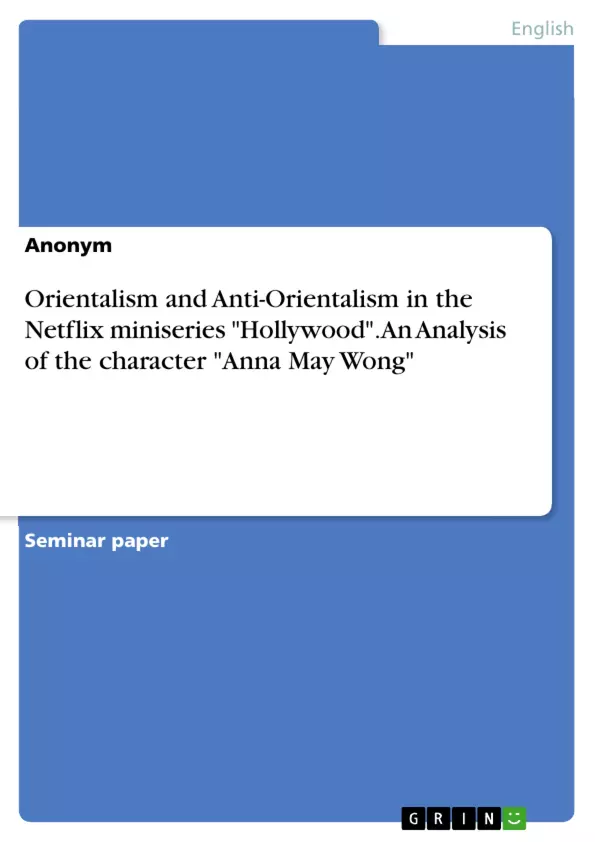This paper examines the cultural discourses of Orientalism and Anti-Orientalism in American cinema, focusing on the representation of the character Anna May Wong in the Netflix miniseries "Hollywood." By analyzing the portrayal of Wong, a pioneering Chinese American actress, the paper explores how Orientalist stereotypes were perpetuated during the Golden Age of Hollywood and how these representations reflect broader cultural prejudices and power dynamics. The study highlights Wong’s struggle against being typecast in stereotypical roles, her efforts to dismantle these stereotypes, and her advocacy for more nuanced and equitable portrayals of Asian women in film. Despite the miniseries' attempt to challenge Orientalism by reimagining Hollywood's history with a more inclusive narrative, it still relies on some stereotypical portrayals, underscoring the persistence of these issues in contemporary media. The paper concludes by emphasizing the need for more accurate and diverse representations in the entertainment industry to combat historical and ongoing discrimination.
Inhaltsverzeichnis (Table of Contents)
- Orientalism and Anti-Orientalism in the Netflix miniseries Hollywood: An Analysis of the character Anna May Wong
- Introduction: Orientalism and Hollywood
- Anna May Wong: A Victim and Advocate
- The Orientalist Imagination: A Distorted View of the East
- The Western Male Gaze: Power and the Construction of Stereotypes
- Orientalist Tropes in Hollywood: The "Vamp" and the "China Doll"
- Anti-Orientalism and Anna May Wong's Resistance
- The Persistence of Stereotypes in the Miniseries
- Conclusion: Challenging Orientalism and Embracing Inclusive Representation
Zielsetzung und Themenschwerpunkte (Objectives and Key Themes)
This essay aims to analyze the cultural discourses surrounding Orientalism and Anti-Orientalism within American cinema, focusing on the character of Anna May Wong in the Netflix miniseries Hollywood. By examining the pioneering Asian American actress's career, the essay seeks to explore how Orientalism is perpetuated through biased representations during the Golden Age of Hollywood, reflecting cultural prejudices and power dynamics between the West and the East.
- Orientalism and Anti-Orientalism in Hollywood
- Stereotypical Representations of Asian Women in Cinema
- The Western Male Gaze and the Construction of Orientalist Images
- Anna May Wong's Resistance Against Orientalist Tropes
- The Need for Inclusive and Accurate Representations of Cultural Diversity
Zusammenfassung der Kapitel (Chapter Summaries)
The essay begins by introducing the concept of Orientalism, as defined by Edward Said, and its influence on Hollywood's representation of the Eastern world. It then focuses on Anna May Wong, showcasing her career as a victim of Orientalist stereotypes and an advocate for Anti-Orientalism. The essay explores the Western male gaze and its role in constructing Orientalist images, highlighting how the stereotypical representations of Asian women perpetuate harmful narratives. It then examines the specific tropes of the "vamp" and the "China Doll," and how these tropes reflect colonialist ideologies and perpetuate notions of Western superiority. The essay concludes by discussing Anna May Wong's efforts to resist these stereotypes and the miniseries' overall attempt to challenge Orientalism.
Schlüsselwörter (Keywords)
This essay focuses on key terms like Orientalism, Anti-Orientalism, Hollywood, Asian American representation, Anna May Wong, Western male gaze, stereotypes, "vamp," "China Doll," and inclusive representation.
- Quote paper
- Anonym (Author), 2023, Orientalism and Anti-Orientalism in the Netflix miniseries "Hollywood". An Analysis of the character "Anna May Wong", Munich, GRIN Verlag, https://www.grin.com/document/1485139



